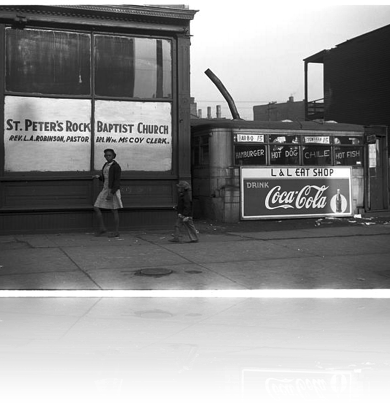
A Short History
The South Side’s earliest religious communities, which originated before most of the area was incorporated into the city of Chicago, were white and Protestant. They gathered in Presbyterian, Congregational, Unitarian, Episcopalian, and Reformed congregations along the south lakeshore. In later years, immigration from southern and central Europe brought more Roman Catholics and Jews to the South Side.
As the Great Migration brought large numbers of African Americans to Chicago, the South Side’s religious landscape changed dramatically. Many Jewish congregations sold their synagogues to black Protestant congregations, most notably the famous Pilgrim Baptist Church (destroyed in a fire in 2006). The building housing Pilgrim had opened in 1891 as Kehilath Anshe Ma'ariv synagogue and was built on a Louis Sullivan design. The Methodist, Baptist, and Pentecostal churches more typical of the African American community also began to replace older Catholic and Protestant churches. African American churches encountered resistance, including firebombing, as they moved into places of worship formerly owned by whites.
A number of Roman Catholic parishes survived and even thrived as the neighborhoods changed. St. Anselm, St. Ambrose, and Corpus Christi parishes—all portrayed in James Farrell’s fiction as centers of the white immigrant communities of the South Side—became centers of African American Catholic life in Washington Park and Kenwood.
Less conventional religious movements developed a influential presence in the new South Side along with the established African American religious institutions. Prince Hall Freemasonry, a movement born out of racial restrictions on membership in white Masonic groups, was popular on the South Side. It shared a spirit of occult mysticism and ethnic pride with other religious movements, most notably the Moorish Science Temple and the Nation of Islam. While Christianity was a major influence in these movements, they did not typically accept the teachings of the churches as fully true or authentic. These groups played a significant role in the rise of the Black Nationalist and Black Power movements throughout the 20th century.
Today, the religious life of the South Side is probably more diverse than it has ever been. A short tour can take you from the venerable synagogues and multi-racial Protestant churches of Hyde Park to the storefront Baptist and Pentecostal congregations that have sprung up since the Great Migration, the monuments of the early African American church in Chicago, some of the country’s most historic African-American Catholic parishes, and finally to the megachurches that characterize much of the new South Side.
Further Reading:
Wallace Best, Passionately Human, No Less Divine: Religion and Culture in Black Chicago, 1915-1952 (Princeton, NJ: Princeton University Press, 2005)
Lowell W. Livezey and Mark Bouman, “Religious Geography,” Encyclopedia of Chicago, James Grossman, Ann Durkin Keating and Janice L. Reiff, eds. (Chicago: University of Chicago Press, 2004)
Martin E. Marty “Chicago’s Influence on Religion,” Encyclopedia of Chicago, James Grossman, Ann Durkin Keating and Janice L. Reiff, eds. (Chicago: University of Chicago Press, 2004)
Dominic A. Pacyga and Ellen Skerrett, Chicago, City of Neighborhoods: Histories and Tours (Chicago: Loyola University Press, 1986)
John F. Szwed, Space is the Place: The Lives and Times of Sun Ra (New York: Pantheon Books, 1997)
Religion

Learn More


uchicago®  ©2007 The University of Chicago®
©2007 The University of Chicago®  5801 South Ellis Ave., Chicago, IL 60637
5801 South Ellis Ave., Chicago, IL 60637  773-702-1234
773-702-1234
 ©2007 The University of Chicago®
©2007 The University of Chicago®  5801 South Ellis Ave., Chicago, IL 60637
5801 South Ellis Ave., Chicago, IL 60637  773-702-1234
773-702-1234 

Image sources
Kneeling in pews: Library of Congress, Prints & Photographs Division, FSA/OWI Collection, LC-USW3-000135-D (b&w film neg.)
Storefront church: Library of Congress, Prints & Photographs Division, FSA/OWI Collection, LC-USF33- 005184-M4 [P&P]